
The Subtle Dance: Illuminating Modern Interiors ✨
The interplay of light and shadow is far more than a functional necessity; it is an ancient art form, fundamental to shaping our perception of space, mood, and even time. For centuries, designers have understood light's power to reveal, conceal, and transform, while shadow adds depth and definition. This foundational understanding continues to evolve, finding new expressions in contemporary interior design practices.
In modern interior design, illumination has transcended mere brightness. We're witnessing a significant shift from simply "lighting up" a room to meticulously crafting atmosphere through sophisticated light and shadow manipulation. Contemporary research highlights the profound psychological and emotional impact of light quality, direction, and intensity. Ambiance is now an integral part of the design narrative, influencing well-being.
Recent explorations into human perception and environmental psychology further underscore the critical role of light and shadow in shaping our experience of indoor spaces. Observations suggest our brains interpret these visual cues, influencing our sense of enclosure, openness, and biological rhythms. This nuanced understanding moves beyond simple aesthetics, demanding a holistic design approach.
Key Insights from Luminous Design Studies 💡
-
Light's color temperature profoundly influences mood and perceived warmth. Warmer tones foster relaxation, while cooler tones enhance alertness and focus, impacting spatial comfort.
-
Dynamic lighting, varying intensity or direction, enhances spatial depth. It creates compelling focal points and adds vitality, transforming static interiors into engaging environments.
-
Strategic shadow application defines form, adds dramatic effect, and provides crucial visual resting points. It prevents spaces from feeling monotonous, enhancing visual interest and depth.
Interpreting the Luminous Landscape 🌓
These findings challenge designers beyond simplistic illumination. It's not about brightness, but the quality and intentionality of light. Designers now meticulously consider how light falls, reflects, and interacts with surfaces, using it as a sculptural element. Formexpqty integrates advanced lighting concepts to create truly immersive experiences.
Psychologically, light's impact is undeniable. Warm, soft light transforms rooms into cozy retreats, inviting relaxation. Conversely, crisp, cool light in workspaces sharpens focus. Careful selection of light sources, considering Kelvin temperature and color rendering, is paramount for desired emotional and functional responses.
Shadow, often overlooked, is equally vital. It provides contrast, allowing illuminated elements to stand out. Without shadow, a space can feel flat. Strategic shadows create intimacy, define pathways, or highlight architectural details with drama. It’s the negative space that gives positive form its power.
The seamless integration of natural and artificial light sources is critical. They should complement each other, adapting throughout the day. Smart lighting systems can mimic natural circadian rhythms, adjusting artificial light to support human well-being. This harmony ensures a space feels balanced and alive, regardless of external conditions, a goal Formexpqty always strives for.
Balancing elements for multi-functional spaces presents a unique challenge. A living room requires bright task light, soft ambient light for entertaining, and accent lighting for art. Layering different types of illumination allows versatile control, tailoring ambiance to specific needs and preferences.
Transforming Spaces: Practical Applications 🌟
-
Enhanced Well-being: Thoughtfully designed lighting significantly improves user comfort, mood, and overall well-being, fostering environments that support productivity and relaxation.
-
Distinctive Identity: Strategic light and shadow manipulation enables unique, memorable spaces, articulating specific moods, brand identities, or desired user experiences effectively.
-
Optimized Perception: Artful illumination dramatically alters spatial perception, making smaller rooms feel expansive or large areas more intimate, enhancing overall functionality.
Comments 6
Anvitha Shukla
5days agoThank you for your feedback! We're glad you found the overview helpful. Formexpqty has several case studies on our website showcasing projects where we've implemented dynamic lighting and strategic shadow play to enhance ambiance. We'd be happy to share some specific examples if you reach out to our design team!
ReplySandhya Gadhavi
8days agoAbsolutely loved the emphasis on the psychological impact of light. It's something often overlooked but so crucial for creating truly comfortable spaces. The insights on dynamic lighting were particularly engaging!
ReplyPrabhat Puri
5days agoWe're thrilled you resonated with the psychological aspects! It's a core philosophy at Formexpqty. We believe understanding human response to light is key to designing spaces that truly nurture and inspire. Thank you for your kind words!
ReplyArjun Rathi
8days agoThe point about balancing natural and artificial light is very relevant today. It's challenging to achieve a seamless blend. Any tips on how to start integrating smart systems effectively in existing designs?
ReplyGauri Iyer
5days agoThat's a great question! Integrating smart systems into existing designs often starts with assessing current infrastructure and identifying key areas for enhancement. We recommend consulting with a lighting design specialist to explore options like smart dimmers, automated blinds, and tunable white light systems, which can be phased in for optimal impact without extensive renovation.
Reply
Sudhir Kapoor
8days agoThis article provides a good overview of light and shadow in design. It clearly explains the shift from purely functional lighting. I'm curious about specific examples of Formexpqty projects that exemplify these principles.
Reply